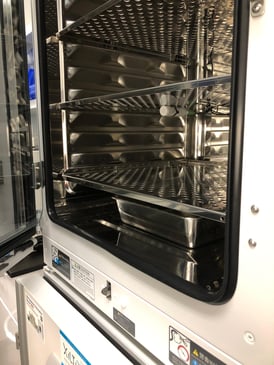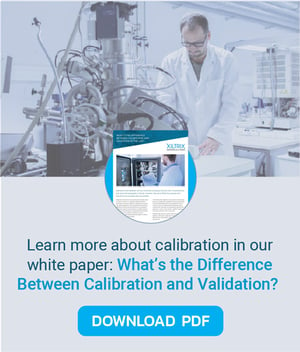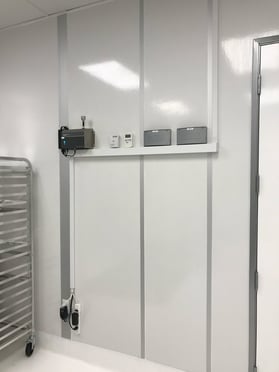As a scientist, minimizing variability is a key part of your job. Calibration, the process of adjusting and validating the accuracy of measuring instruments and equipment, is crucial to this task. Taking measurements for data integrity requires careful calibration of what you are trying to measure. Proper calibration ensures that measurements are accurate and reliable, supporting data integrity. Additionally, calibration is essential for FDA approval and compliance with other regulations. According to Title 21 of the FDA’s Code of Federal Regulations, section 820.72, manufacturers must ensure proper inspection, measurement, and testing to produce valid results for their intended purposes.
Key Considerations for Calibration
 Calibrating laboratory equipment can often feel like an endless investigation. The complexity increases with the number of parameters involved. One crucial decision is whether to perform calibration offsite or onsite, each with its own pros and cons. This choice depends on various factors, including:
Calibrating laboratory equipment can often feel like an endless investigation. The complexity increases with the number of parameters involved. One crucial decision is whether to perform calibration offsite or onsite, each with its own pros and cons. This choice depends on various factors, including:
- Type of instruments
- Industry requirements
- Availability of resources
- Level of accuracy
As you consider onsite and offsite calibration, keep these pros and cons in mind.
Pros of Offsite Calibration
1. Used for Exceptional Cases
In certain situations, such as those involving radioactive or biohazardous materials, it is safer to send probes out for calibration rather than bringing the calibration equipment to the facility. This minimizes risks to personnel, the environment, and the public. By using a specialized external facility, handling hazardous materials is conducted in a controlled and secure manner, reducing the potential for accidents or contamination.
Another unique case benefiting from offsite calibration is continuous particle counters. These devices draw in air through a sampling inlet and pass it through a detection chamber. These devices measure the concentration of airborne particles like dust, smoke, pollen, and other particulates. Owning and maintaining particle counters is expensive and requires specialized expertise. Therefore, most particle counters are sent to specialized facilities for calibration.
2. Ideal for Sending Large Volumes of Equipment
For large volumes of sensors needing calibration, larger facilities can expedite the process, saving valuable time and resources. These facilities ensure efficient documentation of calibration results, adjustments made, and standards used. Such documentation is crucial for demonstrating compliance with regulatory requirements, including FDA regulations, GxP guidelines, quality standards, and customer specifications. Having well-documented records readily available facilitates easy audits, inspections, and validation of processes, ensuring adherence to industry regulations and maintaining the highest quality standards.
Cons of Offsite Calibration
1. Potential Damage During Transit
Transporting probes for offsite calibration carries the risk of damage, which can result in inaccurate calibration and costly repairs. This can lead to:
- Calibration drift
- Additional costs for insurance and liability
- Downtime and delay
- Lack of immediate feedback
- Reduced control over the process
Carefully consider these factors when deciding between offsite and onsite calibration and take appropriate measures to mitigate the risks associated with shipping probes or instruments for calibration.
2. Inaccurate Calibration Due to Environmental Differences
Environmental differences between the calibration facility and the onsite location can affect calibration accuracy. Changes in altitude or atmospheric pressure can impact instrument performance, and if calibration is not conducted under similar conditions to the typical operating environment, the results may not be accurate in real-world applications. Calibration should aim to be as accurate as possible in the actual conditions where the equipment and sensors are used.
3. Risk of Delays
Delays during transit can result in equipment downtime and lost productivity. Delays in shipping and processing times at calibration facilities can significantly hinder the arrival of properly calibrated probes, and processing times at calibration facilities can vary. Communication challenges, both internal and external, can also cause delays, particularly on a global scale.
4. Logistical Challenges
Offsite calibration requires removing and shipping probes or instruments to a calibration facility, causing downtime and needing additional resources for uninstallation and reinstallation. This can backlog other tasks and necessitate replacement probes. Tracking the movement and installation of multiple sensors and devices can become cumbersome and increase the risk of manual errors. These logistical challenges multiply with the number of sensors and devices involved in the calibration process.
Offsite Calibration Presents Costly Challenges
Managing the shipping and logistics of equipment for offsite calibration can be both time-consuming and expensive for customers. Additionally, there is a risk of equipment damage or loss during transit, leading to further delays and expenses. Offsite calibration also introduces uncertainty regarding calibration accuracy, as customers have limited control and cannot directly observe the calibration process. In summary, offsite calibration poses significant challenges in terms of management and potential costs.
Pros of Onsite Calibration
1. Increased Real-Life Accuracy
By opting for onsite calibration, the calibration process takes place within the precise environment where the sensor is utilized. Consequently, calibration occurs under identical conditions, encompassing temperature, humidity, pressure, and other environmental variables that the equipment will encounter during regular operation. This contextual precision enhances the accuracy of calibration results since the equipment is calibrated in real-life conditions that closely mirror its actual usage environment, reducing potential disparities between calibration and practical operating conditions.// Opting for onsite calibration means that the process takes place within the exact environment where the sensor is used. Calibration occurs under the same conditions (temperature, humidity, pressure, and other environmental variables) that the equipment will encounter during regular operation. This contextual precision enhances the accuracy of calibration results by closely mirroring the actual usage environment, reducing potential discrepancies between calibration and practical operating conditions.
2. Real-Time reactions
Onsite calibration allows for immediate detection and correction of any deviations or inaccuracies in equipment measurements or readings. This provides real-time feedback on the accuracy and reliability of the equipment, enabling prompt adjustments to ensure accurate results. This is particularly important in critical applications where precise measurements are essential for maintaining quality, safety, or compliance.
3. Better Control Over the Calibration Process
Onsite calibration offers better control over the administrative process by employing the "four eyes principle" and real-time offset data upload into EMS or customer quality systems. The four-eye principle involves independent review and verification by at least two individuals, enhancing accuracy, quality control, accountability, and compliance. Proper training, qualifications, and adherence to procedures and standards are crucial for effective implementation. With XiltriX, the SafetyNet team logs offsets in the EMS to help monitor your critical lab assets.
 Cons of Onsite Calibration
Cons of Onsite Calibration
1. Not Possible for Every Type of Sensor
Onsite calibration may not be feasible for certain types of sensors that require specialized calibration equipment or facilities. Some sensors have technical limitations that prevent onsite setup, and others require specific certifications to be properly calibrated according to industry standards.
2. Equipment Downtime
Onsite calibration can cause equipment downtime and lost productivity, as the equipment must be made available to the calibration specialist. This process involves handling equipment setup or disassembly, addressing concerns, and providing necessary information. Involving your technician and Lab Manager early in the process ensures task alignment and preparedness for calibration.
3. Longer Process
Factors such as the availability of the calibration specialist, and logistical and operational delays can extend the calibration process. With the process out of your direct control, these factors can contribute to longer calibration times.
Onsite Calibration Results in Better Accuracy
Onsite calibration improves accuracy by calibrating equipment in its actual operating environment, eliminating the need for shipping and reducing downtime. With XiltriX SafetyNet, the process is managed efficiently, relieving stress for the lab manager. It also enables the "four eyes principle," ensuring accurate and consistent calibration by involving two qualified technicians.
Conclusion
Both sending out probes for calibration and onsite calibration have their advantages and drawbacks. Sending out probes is suitable for exceptional cases but can lead to inaccuracies, delays, and logistical challenges. Onsite calibration offers increased accuracy, real-time adjustments, and consistency, although it may result in equipment downtime and longer calibration times.
Organizations must carefully evaluate these options, considering cost, accuracy, equipment accessibility, time constraints, regulatory compliance, and their capabilities. By making an informed decision, they can ensure reliable calibration results that align with their requirements and quality standards.
Ultimately, onsite calibration is often a better option for cost-effectiveness, time-saving, and resource efficiency, as well as ensuring compliance with standard operating procedures (SOPs). As a scientist, achieving accuracy is paramount. Onsite calibration provides more accurate measurements and ensures data integrity. It is the clear winner in reducing variability and achieving accurate data.
Choose XiltriX and Get High-Quality SensorsXiltriX offers Monitoring-as-a-Service, taking care of sourcing, installing, and maintaining all the sensors needed to keep a pulse on your facility. We provide the flexibility to either manage the calibration process for you or work with your preferred calibration vendor, tailored to your needs. |
